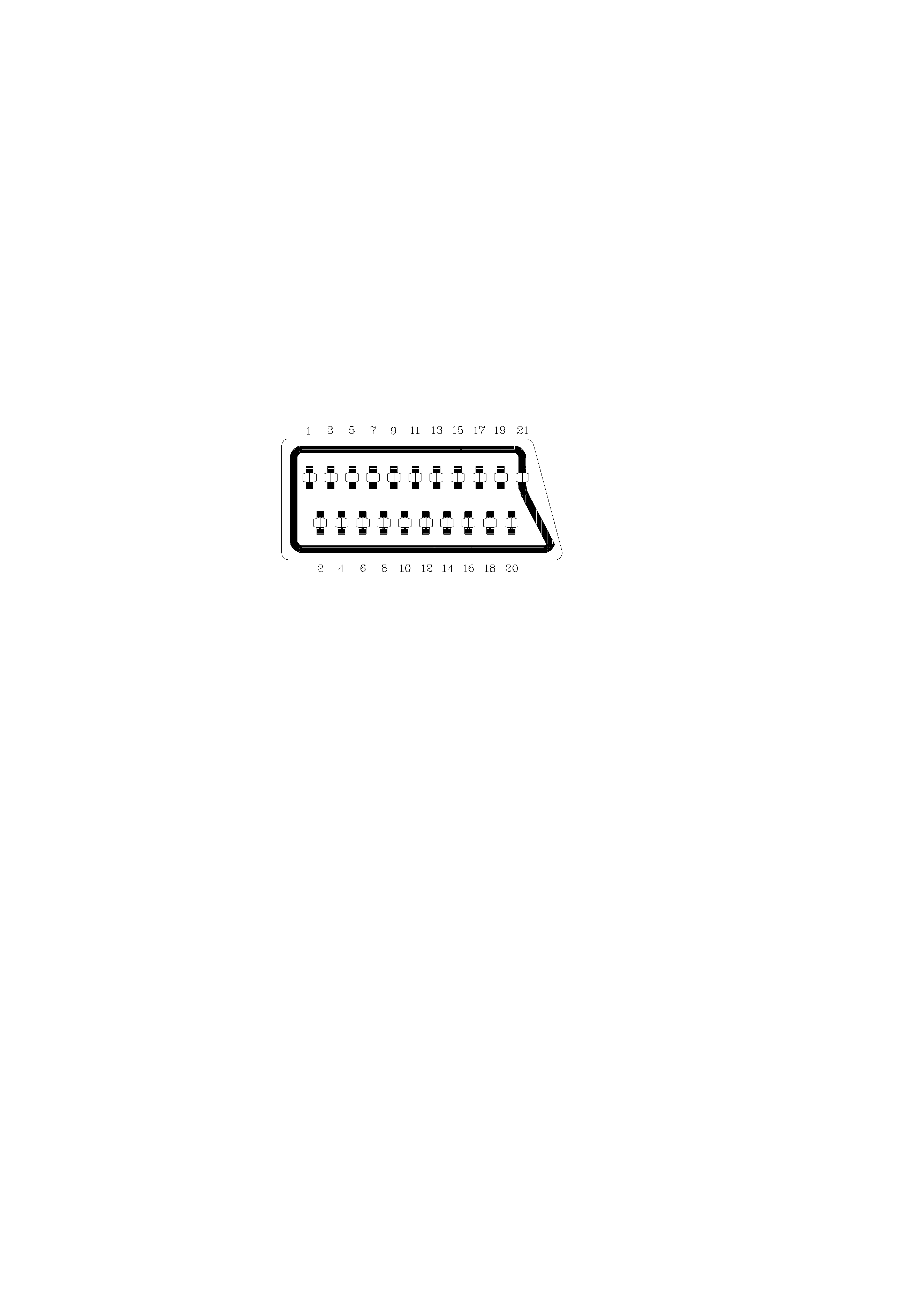
August 2000
No. 0106
CP2025T
C2125T/S
CL2125T/S
CP2125T/S
C2142N/S
CL2142AN/S
CP2142AN/S
C2842N/S
CL2842AN/S
CP2842AN/S
SERVICE MANUAL
MANUEL D'ENTRETIEN
WARTUNGSHANDBUCH
CAUTION:
Before servicing this chassis, it is important that the service technician
read the "Safety Precautions" and "Product Safety Notices" in this
service manual.
ATTENTION:
Avant d'effectuer l'entretien du châassis, le technicien doit lire les
«Précautions de sécurité» et les «Notices de sécurité du produit»
présentés dans le présent manuel.
VORSICHT:
Vor Öffnen des Gehäuses hat der Service-Ingenieur die
,,Sicherheitshinweise" und ,,Hinweise zur Produktsicherheit" in diesem
Wartungshandbuch zu lesen.
Data contained within this
Service manual is subject to
alteration for improvement.
Les données fournies dans le
présent manuel d'entretien
peuvent faire l'objet de
modifications en vue de
perfectionner le produit.
Die in diesem
Wartungshandbuch enthaltenen
Spezifikationen können sich
zwecks Verbesserungen ändern.

ENGLISH
SAFETY PRECAUTIONS
WARNING: The following precautions must be observed.
ALL PRODUCTS
Before any service is performed on the chassis an
isolation transformer should be inserted between the
power line and the product.
1. When replacing the chassis in the cabinet, ensure
all the protective devices are put back in place.
2. When service is required, observe the original
lead dressing. Extra precaution should be taken to
ensure correct lead dressing in any high voltage
circuitry area.
3. Many electrical
and
mechanical parts in
HITACHI products have special safety related
characteristics. These characteristics are often not
evident from visual inspection, nor can the
protection afforded by them necessarily be
obtained by using replacement components rated
for higher voltage, wattage, etc. Replacement
parts
which
have
these
special
safety
characteristics are identified by marking with a
! on the schematics and the replacement parts
list.
The use of a substitute replacement component
that does not have the same safety characteristics
as the HITACHI recommended replacement one,
shown in the parts list, may create electrical
shock, fire, X-radiation, or other hazards.
4. Always replace original spacers and maintain lead
lengths. Furthermore, where a short circuit has
occurred, replace those components that indicate
evidence of overheating.
5. Insulation resistance should not be less than 2M
ohms at 500V DC between the main poles and
any accessible metal parts.
6. No flashover or breakdown should occur during
the dielectric strength test, applying 3kV AC or
4.25kV DC for two seconds between the main
poles and accessible metal parts.
7. Before returning a serviced product to the
customer, the service technician must thoroughly
test the unit to be certain that it is completely safe
to operate without danger of electrical shock. The
service technician must make sure that no
protective device built into the instrument by the
manufacturer
has
become
defective,
or
inadvertently damaged during servicing.
CE MARK
1. HITACHI products may contain the CE mark on
the rating plate indicating that the product
contains parts that have been specifically
approved
to
provide
electromagnetic
compatibility to designated levels.
2. When replacing any part in this product, please
use only the correct part itemised in the parts list
to ensure this standard is maintained, and take
care to replace lead dressing to its original state,
as this can have a bearing on the electromagnetic
radiation/immunity.
PICTURE TUBE
1. The line output stage can develop voltages in
excess of 25kV; if the E.H.T. cap is required to be
removed, discharge the anode to chassis via a
high value resistor, prior to its removal from the
picture tube.
2. High voltage should always be kept at the rated
value of the chassis and no higher. Operating at
higher voltages may cause a failure of the picture
tube or high voltage supply, and also, under
certain circumstances could produce X-radiation
levels moderately in excess of design levels. The
high voltage must not, under any circumstances,
exceed 29kV on the chassis (except for projection
Televisions).
3. The primary source of X-radiation in the product
is the picture tube. The picture tube utilised for
the above mentioned function in this chassis is
specially constructed to limit X-radiation. For
continued X-radiation protection, replace tube
with the same type as the original HITACHI
approved type
4. Keep the picture tube away from the body while
handling. Do not install, remove, or handle the
picture tube in any manner unless shatterproof
goggles are worn. People not so equipped should
be kept away while picture tubes are handled
LASERS
If the product contains a laser avoid direct exposure to
the beam when the cover is open or when interlocks are
defeated or have failed.

Contents
Contents...................................................................................................................................................2
Safety Precautions.................................................................................................................................3
TV Set switched off.................................................................................................................................3
Measurement.........................................................................................................................................3
PERI-TV SOCKET...................................................................................................................................
.3
SCART 1..................................................................................................................................................3
SCART 2..................................................................................................................................................3
INTRODUCTION....................................................................................................................................3
SMALL SIGNAL PART WITH TDA884X.................................................................................................3-4
TUNER...................................................................................................................................................5
VIDEO SWITCH TEA6415C....................................................................................................................5
AM DEMODULATORTDA9830...............................................................................................................6
DIGITAL TV SOUND PROCESSOR TDA9875........................................................................................6
SOUND OUTPUT STAGE TDA2615/TDA2616Q....................................................................................6
VERTICAL OUTPUT STAGE WITH TDA8351/TDA8356........................................................................7
VIDEO OUTPUT AMPLIFIER TDA6107Q...............................................................................................7
SINGLE/MULTISTANDARD VIF/SIF- PL and FM-PLL/AM DEMODULATOR TDA9818...........................7
COMB FILTER SAA497Q.......................................................................................................................7
POWER SUPPLY (SMPS).......................................................................................................................7
MICROCONTROLLER SDA525X............................................................................................................7
SERIAL ACCESS CMOS 8K(1024*8)EEPROM ST24C08.......................................................................7
CLASS AB STEREO HEADPHONE DRIVER TDA1308..........................................................................8
SAW FILTERS............................................................................................................................................8
IC DESCRIPTIONSand INTERNAL BLOCK DIAGRAM..........................................................................8
TDA8840/TDA8842/TDA8844..............................................................................................................8
UV1315/UV1316/UV1336..................................................................................................................10
TEA6415C..........................................................................................................................................11
TDA9830.............................................................................................................................................11
TDA2614/TDA2615/TDA2616Q...........................................................................................................12
TDA8351/TDA8356.............................................................................................................................13
TDA6107Q...........................................................................................................................................
13
SAA4961............................................................................................................................................14
MC44604.............................................................................................................................................14
SDA525X.............................................................................................................................................15
TDA9875.............................................................................................................................................17
TDA9818..............................................................................................................................................18
ST24C08................................................................................................................................................
..19
TDA1308..............................................................................................................................................19
G1965M...............................................................................................................................................19
TDA9855...............................................................................................................................................20
MANUAL ADJUSTMENT PROCEDURE....................................................................................................21
WHITE BALANCE ADJUSTMENT.........................................................................................................21
AGC ADJUSTMENT..............................................................................................................................21
IF- PL NEGATIVE ADJUSTMENT...........................................................................................................21
IF- PLL POSITIVE ADJUSTMENT..........................................................................................................21
LUMINANCEDELAY ADJUSTMENT.....................................................................................................21
VERTICAL ZOOM ADJUSTMENT........................................................................................................21
VERTICAL SCROLL ADJUSTMENT.................................................................................................... 21
GENERAL BLOCK DIAGRAM..................................................................................................................
OPTION SETTINGS...............................................................................................................................
ELECTRONICPARTS LISTS....................................................................................................................
SCHEMATIC DRAWING.............................................................................................................................
4:3 HORIZONTAL SHIFT ADJUSTMENT........................................................................................
4:3 VERTICAL SLOPE ADJUSTMENT............................................................................................
4:3 VERTICAL AMPLITUDE ADJUSTMENT....................................................................................
4:3 S-CORRECTION ADJUSTMENT...............................................................................................
4:3 VERTICAL SHIFT ADJUSTMENT..............................................................................................
4:3 EW WIDTH ADJUSTMENT........................................................................................................
4:3 EW PARABOLA WIDTH ADJUSTMENT....................................................................................
4:3 EW CORNER PARABOLA ADJUSTMENT................................................................................
4:3 EW TRAPEZIUM ADJUSTMENT...............................................................................................
16:9 HORIZONTAL SHIFT ADJUSTMENT.......................................................................................
16:9 VERTICAL SLOPE ADJUSTMENT ..........................................................................................
16:9 VERTICAL AMPLITUDE ADJUSTMENT..................................................................................
16:9 S-CORRECTION ADJUSTMENT.............................................................................................
16:9 VERTICAL SHIFT ADJUSTMENT............................................................................................
16:9 EW WIDTH ADJUSTMENT.......................................................................................................
16:9 EW PARABOLA WIDTH ADJUSTMENT..................................................................................
16:9 EW CORNER PARABOLA ADJUSTMENT..............................................................................
16:9 EW TRAPEZIUM ADJUSTMENT.............................................................................................
21
22
22
22
22
22
22
22
22
22
22
22
22
22
22
22-23
23
23
24
25-61
62-72
73-74
2
OPTION 00........................................................................................................................................27
OPTION 01........................................................................................................................................27
OPTION 02........................................................................................................................................27
OPTION 03........................................................................................................................................28
OPTION 04........................................................................................................................................28
OPTION 05........................................................................................................................................28
OPTION 06........................................................................................................................................29
OPTION 07........................................................................................................................................29-30
OPTION 08........................................................................................................................................30-31
OPTION 09........................................................................................................................................31
OPTION 10........................................................................................................................................32

3
DO NOT CHANGE ANY MODULE UNLESS THE SET IS SWITCHED OFF
The mains supply side of the switch mode power supply transformer is live.
Use an isolating transformer.
The receivers fulfill completely the safety requirements.
Safety precautions:
Servicing of this TV should only be carried out by a qualified person.
- Components marked with the warning symbol on the circuit diagram are critical for safety and must only be replaced with an identical
component.
- Power resistor and fusable resistors must be mounted in an identical manner to the original component.
- When servicing this TV, check that the EHT does not exceed 26kV.
TV Set switched off:
Make short-circuit between HV-CRT clip and CRT ground layer.
Short C804 (150mF) before changing IC802 or other components in primary side of SMPS.
Measurements:
Voltage readings and oscilloscope traces are measured under following conditions.
Antenna signal 60dB from colourbar generator. (100% white, 75% colour saturation)
Brightness, contrast, colour set for a normal picture.
Mains supply, 220VAC, 50Hz.
PERI-TV SOCKET
SCART 1 (SC050)
SCART 2 (SC051)
1
Audio right output
0.5Vrms / 1K
1 Audio right output
0.5Vrms / 1K
2
Audio right input
0.5Vrms / 10K
2 Audio right input
0.5Vrms / 10K
3
Audio left output
0.5Vrms / 1K
3 Audio left output
0.5Vrms / 1K
4
Ground AF
4 Ground AF
5
Ground Blue
5 Ground Blue
6
Audio left input
0.5Vrms / 10K
6 Audio left input
0.5Vrms / 10K
7
Blue input
0.7Vpp / 75ohm
7 Blue input
0.7Vpp / 75ohm
8
AV switching input
0-12VDC /10K
8 AV switching input
0-12VDC /10K
9
Ground Green
9 Ground Green
10 -
10 -
11 Green input
0.7Vpp / 75ohm
11 -
12 -
12 -
13 Ground Red
13 Ground Red
14 Ground Blanking
14 Ground Blanking
15 Red input
0.7Vpp / 75ohm
15 -
16 Blanking input
0-0.4VDC, 1-3VDC / 75ohm
16 -
17 Ground CVS output
17 Ground CVS output
18 Ground CVS input
18 Ground CVS input
19 CVS output
1Vpp / 75ohm
19 CVS output
1Vpp / 75ohm
20 CVS input
1Vpp / 75ohm
20 CVS input
1Vpp / 75ohm
21 Ground
21 Ground
1. INTRODUCTION
This
is a 90ø and 110ø chassis capable of driving 20-21,24,25,28-29,32,33 tubes at appropriate currents.
The chassis is capable of working in both PAL and SECAM. The sound system is capable of giving 6watts
RMS output into a load of 8ohms.
One 8 page simple TELETEXT, TOPTEXT and FASTEXT is provided.
The chassis is equipped with 21-pin scart connectors which can accept via scart the SVHS format from VCRs so equipped.
2. SMALL SIGNAL PART WITH TDA884X
The TDA8840/8842/8844 combine all small signal functions required for a colour TV receiver, except tuning.
2.1. Vision IF amplifier
The IF-amplifier contains 3 AC-coupled control stages with a total gain control range which is higher than 66dB.
The sensitivity of the circuit is comparable with that of modern IF-IC s. The video signal is demodulated by means of a PLL
carrier regenerator. This circuit contains a frequency detector and a phase detector. The AFC output is obtained by using the
VCO control voltage of the PLL and can be read via the I²C-bus. For fast search tuning systems the window of
the AFC can be increased with a factor 3. The setting is realised with the AFW bit.
Depending on the type the AGC-detector operates on top-sync level (single standard versions) or on top sync and top
white-level (multi standard versions). The demodulation polarity is switched via the I²C-bus. The AGC detector time-constant capacitor
is connected externally. This mainly because of the flexibility of the application. The time-constant of the AGC system during positive

4
modulation is rather long to avoid visible variations of the signal amplitude. To improve the speed of the AGC system a circuit has
been included which detects whether the AGC detector is activated every frame period. When during 3 frame periods no action is
detected the speed of the system is increased. For signals without peak white information the system switches automatically to a
gated black level AGC. Because a black level clamp pulse is required for this way of operation the circuit will only switch to black level
AGC in the internal mode.
The circuits contain a video identification circuit which is independent of the synchronisation circuit. Therefore search tuning is
possible when the display section of the receiver is used as a monitor. The ident output is supplied to the tuning system via the
I²C-bus. The video ident circuit can be made less sensitive by means of the STM bit. This mode can be used during search tuning
to avoid that the tuning system will stop at very weak input signals.
2.2. Video Switches
The circuits have two CVBS inputs (internal and external CVBS) and Y/C input. When the Y/C input is not required the Y input can be
used as third CVBS input. The selection of the various sources is made via the I²C-bus. The circuit has one CVBS output.
2.3. Sound Circuit
The sound band pass and trap filters have to be connected externally. The filtered intercarrier signal is fed to a limiter circuit
and is demodulated by means of a PLL demodulator. This PLL circuit tunes itself automatically to the incoming carrier signal
so that no adjustment is required.
The volume is controlled via the I²C-bus. The deemphasis capacitor has to be connected externally. The non-controlled audio
signal can be obtained from this pin. The FM demodulator can be muted via the I²C-bus. This function can be used to switch-off
the sound during a channel change so that high output peaks are prevented. The TDA8840/8842 contain an automatic volume
levelling (AVL) circuit which automatically stabilises the audio output signal to a certain level which can be set by the viewer by
means of the volume control. This function prevents big audio output fluctuations due to variations of the modulation depth of the
transmitter. The AVL function can be activated via the I²C-bus.
2.4. Synchronisation circuit
The sync seperator is preceded by a controlled amplifier which adjusts the sync pulse amplitude to a fixed level. These pulses are
fed to the slicing stage which is operating at 50% of the amplitude. The separated sync pulses are fed to the first phase detector and
to the coincidence detector. This coincidence detector is used to detect whether the line oscillator is synchronised and can also be
used for transmitter identification. The first PLL has a very high statical steepness so that the phase of the picture is independent of
the line frequency.
The horizontal output signal is generated by means of an oscillator which is running at twice the line frequency. Its frequency is
divided by 2 to lock the first control loop to the incoming signal. The time-constant of the loop can be forced by the I²C-bus (fast or
slow).
If required the IC can select the time-constant depending on the noise content of the incoming video signal.
To protect the horizontal output transistor, the horizontal drive is immediately switched off when a power-on-reset is detected.
The drive signal is switched-on again when the normal switch-on procedure is followed.
Via the I²C-bus, adjustments can be made of the horizontal and vertical geometry. The vertical sawtooth generator drives the
vertical output drive circuit which has a differrential output current. For the EW drive a single ended current output is available.
When the horizontal scan is reduced to display 4 : 3 pictures on a 16 : 9 picture tube an accurate video blanking can be switched on
to obtain well defined edges on the screen.
Overvoltage conditions can be detected via the EHT tracking pin.When an overvoltage condition is detected the horizontal output
drive signal will be switched-off via the slow stop procedure but it is also possible that the drive is not switched-off and that just a
protection indication is given in the I²C-bus output byte. The choice is made via the input bit PRD.
2.5. Chroma and Luminance processing
The circuits contain a chroma bandpass and trap circuit. The filters are realised by means of gyrator circuits and they are
automatically calibrated by comparing the tuning frequency with the X-tal frequency of the decoder.
The luminance delay line and the delay for the peaking circuit are also realised by means of gyrator circuits.
The centre frequency of the chroma bandpass filter is switchable via the I²C-bus so that the performance can be optimised for
front-end signals and external CVBS signals.
During SECAM reception the centre frequency of the chroma trap is reduced to get a better suppression of the SECAM
carrier frequencies.
2.6. Colour Decoder
The decoder contains an alignment-free X-tal oscillator, a killer circuit and two colour difference demodulators. The 90° phase shift
for the reference signal is made internally.
The IC contains an automatic colour limiting (ACL) circuit which prevents that oversaturation occurs when signals with a high
chroma-to-burst ratio are received. The ACL circuit is designed such that it only reduces the chroma signal and not the burst signal.
This has the advantage that the colour sensitivity is not affected by this function.
The base-band delay line is integrated in the PAL/SECAM IC s.
The demodulated colour difference signals are internally supplied to the delay line. The matrixed signals are externally available.
The colour difference matrix switches automatically between
PAL/SECAM and NTSC, however, it is also possible to fix the matrix in the PAL standard.
Which colour standard the IC can decode depends on the external X-tals. The X-tal to be connected to pin 34 must have a frequency
of 3.5 MHz (NTSC-M, PAL-M or PAL-N) and pin 35 can handle X-tals with a frequency of 4.4 and 3.5 MHz. To prevent calibration
problems of the horizontal oscillator the external switching between the 2 X-tals should be carried out when the oscillator is forced
to pin 35. For a reliable calibration of the horizontal oscillator it is very important that the X-tal indication bits (XA and XB) are not
corrupted. For this reason the X-tal bits can be read in the output bytes so that the software can check the I²C-bus transmission.
2.7. RGB output circuit and black-current stabilisation
The colour-difference signals are matrixed with the luminance signal to obtain the RGB-signals. The TDA 884X device has one
linear RGB input. This RGB signal can be controlled on contrast and brightness.
The output signal has an amplitude of about 2 volts black-to-white at nominal input signals and nominal settings of the controls.
To increase the flexibility of the IC it is possible to insert OSD and/or teletext signals directly at the RGB outputs.
This insertion mode is controlled via the insertion input (pin 26 in the S-DIP 56- and pin 38 in the QFP-64 level). This blanking action
at the RGB outputs has some delay which must be compansated externally.
To obtain an accurate biasing of the picture tube a Continuous Cathode Calibration circuit has been developed.
This function is realised by means of a 2-point black level stabilisation circuit.
